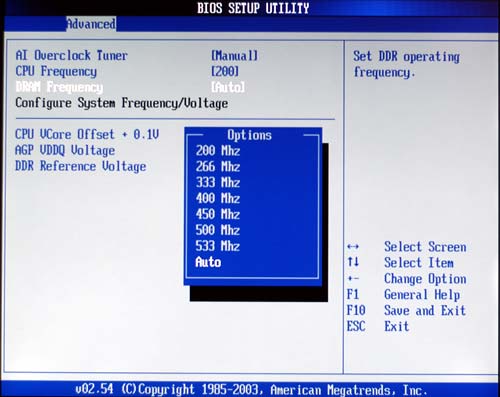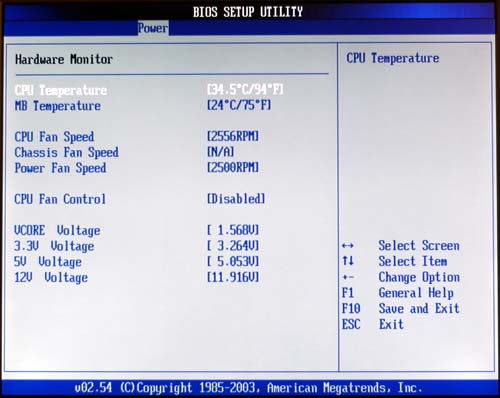Asus P4S800D-E Deluxe & Gigabyte 8S655TX Ultra: SiS 655TX Challenges Intel's Best
by Wesley Fink on December 9, 2003 1:52 PM EST- Posted in
- Motherboards
Asus P4S800D-E: BIOS and Overclocking
Fixed PCI/AGP
SiS provided the ability to fix AGP/PCI in the SiS655, so we expected it to appear as an option on the 655TX. Despite the fact there are no options in the BIOS, there is a PCI/AGP lock on the P4S800D-E — it is always on. Asus states that there is indeed an AGP/PCI lock, despite what you may have heard, and you will see our overclock results confirm that the fixed AGP/PCI is working properly.BIOS

Asus uses AMI BIOS on almost all of their current boards, and the P4S800D-E is no exception. While the layout of the AMI is quite different from the familiar Award layout, it is really easy to use once you get the hang of the logic. Major categories are across the top and each category has many submenus.

Most of the adjustment options we normally use are in the Advanced section.

The “JumperFree Configuration” submenu is where you can adjust CPU Frequency from 100-300, and select from a complete selection of DIMM voltages and AGP voltages. We are accustomed to reduced vCore options on the 800FSB and now Prescott boards, but the only available voltage option is to add +0.1V to the normal voltage. Asus tells us that this will be improved upon in an upcoming BIOS. We will provide more information here when that BIOS update is available.

A wide range of synchronous and asynchronous memory speed options have become a trademark of SiS Intel chipsets. We are happy to report that there are many ratio options available on this Asus. In the “JumperFree” submenu, you will find the ability to set AUTO for memory speed or choose 200, 266, 333, 400, 450, 500, or 533. This range is not as extensive as the Gigabyte board in this review, but it is a lot more than you will find on any Intel-chipset board. Please keep in mind that these settings refer to Base Speed, at a 200 setting of the 800FSB. You are merely starting with this setting or ratio. This means at a setting of 400 and a FSB of 250, you will be running the memory at DDR500. If you start with a 500 memory setting, then a 250FSB setting would mean you are running at DDR625.

Adjustments for memory timings seem to be in an odd place. They are under “Advanced”, “Chipset”, “NorthBridge”. Once you locate them, you will find a complete range of memory timing adjustments.

With a fully loaded system, you could have many bootable devices. That is the purpose of the Boot Menu. Using the options, you can choose which hard drives should be primary boot, and set up the search order for boot devices.

PC Health information is quite complete, but it can be hard to find if you are not familiar with the AMI layout. Look under the Power Menu, “Hardware Monitor” submenu and you will find system temperatures, fan speeds, and voltages.
FSB Overclocking Results
One of the most appealing features of the SiS655-based SINXP was its outstanding overclocking abilities. One of the disappointments of the 655FX was its poor overclocking. We are happy to report that serious SiS overclocking is back with the Asus P4S800D-E! With the initial BIOS supplied by Asus, we found it difficult to boot at any BIOS setting greater than 255 (1020FSB). This is really great performance, but we know of many 2.4 P4 chips that can do 290 or better on a few of the better Intel motherboards. We reported what we had found to Asus who just provided an update, 1001.023 BIOS, which now does 264 with ease into Windows XP at 1:1 ratio, and 267 asynchronously. We were able to boot into DOS at a 280 setting, but the max for XP was 267.| Front Side Bus Overclocking Testbed Default Voltage |
|
| Processor: | Intel Socket 478 3.2 ES |
| CPU Voltage: | 1.55V (default) |
| Cooling: | CoolerMaster IHC-L71 Silent Heat Pipe |
| Power Supply: | Enermax 465W |
| Maximum OC: | 3640 (14x260) and 3484 (13x267) 267FSB |
The above overclocking setup at default voltage allowed us to reach the highest stable FSB of 264 (1056) at 1:1 memory ratio and 267 (1068) asynchronous (5:4). The highest MHz speed with our unlocked ES CPU was achieved at 14x360 or 3.64GHz at default voltage. This is consistent with the performance achieved with this CPU in the top Intel Chipset 865/875 motherboards, and is actually the highest that we have achieved with this ES CPU by a small margin.
The point here is that once again, SiS has a chipset that will not hold back overclocking with most chips. The Asus P4S800D-E will allow almost any 2.6GHz or higher P4 to reach its maximum potential. A good overclocking 2.4 will likely find a 267 setting limiting, but other CPUs will be able to perform at their best in the P4S800D-E. Since Asus was able to improve the maximum overclock with a simple BIOS update, we may also see even better overclocking with future BIOS updates.
For those of you who keep score with memory bandwidth, just a few results will be shared. Sandra 2004 memory benchmarks at 14x260, at 2.5-3-4-7 timings and at 2.75V was 5750 unbuffered, and 3206 unbuffered — results that show convincingly the SiS memory controller in the 655TX to be competitive finally with Intel's excellent 865/875 memory controller.
The memory ratios also allow a few things you simply can't do with an 875/865 chipset. We had no problem running our CPU at 200 (800FSB) while running our DDR500 memory at 500. That is something simply not possible with the ratios available on the 865/875. We never succeeded in running 533 with a 800FSB, but 210 (840) at DDR525 worked fine. We also could do some interesting things in reverse — like run our CPU at 267 (1068) and our memory at DDR400 at tight 2-2-2-6 timings. For owners of 533 processors, we even tried running the CPU at 266 (533) and the memory at DDR400, and it worked just fine. This, again, is something you simply cannot do with an 875/865 chipset board.










24 Comments
View All Comments
WhoBeDaPlaya - Friday, April 23, 2004 - link
LOL swt - wish I got paid for the reviews I write :Pswt - Saturday, February 7, 2004 - link
Having bought the P4S800E, I can correct a couple of misimpressions.First, the passive heatsink on the NB isn't so large as to interfere with my Zalman CNPS-7000Cu. Other mondo coolers might be problematic, of course.
And the AMI BIOS now supports multiple CPU Core settings, all the way up to 1.9V. Since I don't get paid to write such reviews, I'm not going to type in the details - but the BIOS that shipped with the MB *has* been updated in that regard, as promised.
buzzby311 - Tuesday, December 30, 2003 - link
buzzby311 - Tuesday, December 30, 2003 - link
All of the current memory reviews talk about memory that is great for the 865 875 chipsets. What memory would be good for overclocking on this motherboard with an Intel 3.0GHz 800FSB HT processor?Wesley Fink - Monday, December 15, 2003 - link
Asus says the P4S800D-E will appear on their web site on Friday, December 19, 2003. They expect the boards to be available for sale in the US by January 1.ColdRolledSteel - Thursday, December 11, 2003 - link
I also would like to know when the P4S800D-E is coming out. It isn't listed anywhere, including on the usa.asus.com website....Wesley Fink - Wednesday, December 10, 2003 - link
Spacecomber -We normally check FSB and report those that are out of spec. With these 3 boards all are within 0.5MHz of 200. The Asus P4S800D-E is 200.1, and both Gigabyte 8S655TX Ultra and Asus P4C800-E are at 200.5. If numbers are way off we correct them to 200 (800) before running benchmarks if possible.
Spacecomber - Wednesday, December 10, 2003 - link
Unless I missed it, did you check to make sure no one was cheating a bit with their front side bus speed? Is a 200 MHz frontside bus really a 200 MHz frontside bus for all three boards that you compared?Thx
Space
Wesley Fink - Wednesday, December 10, 2003 - link
#14 - All our Benchmark tests on the 655TX boards were done with an ATI 9800 PRO with Fast Writes enabled, so there does not not seem to be a general problem with ATI cards.valnar - Wednesday, December 10, 2003 - link
#3Why would I want to give up that?